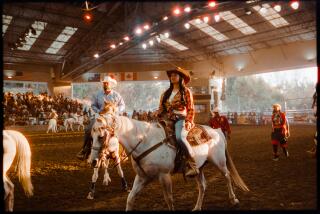The Romance of the Ride on the Rails and the Rods
- Share via
I have a rare letter from the rare Steve Allen asking for my help in explaining, or validating, the term “riding the rods.”
Allen notes that he did some traveling by freight train as a youth, and it seemed to him that the rods suspended beneath the cars were too thin to support a human being for any length of time.
Allen says he also addressed the question to Jim Murray, since Murray had once written that Jack Dempsey had “hoboed around on the bottom of freight cars.”
Oddly, in his letter to Murray, Allen used the phrase “riding the rails,” not “riding the rods.” He told Murray, “Since I spent a lot of time, as a 16-year-old runaway, crossing the country on trains, I one day asked some of my traveling companions if they knew exactly what ‘riding the rails’ meant. None of them did. . . . It’s possible that the ‘rails’ referred to were simply railroad tracks, of course.”
Confusing the question even further, in his reply to Allen, Murray uses the phrase “riding the rods.” Jim said he had asked Dempsey what the term meant and the champ said it meant riding on the struts underneath a freight car. It was dangerous, Dempsey said, but no more so than being arrested by a railroad bull.
I think “riding the rails” simply meant riding by train, but “riding the rods” meant clinging precariously to the rods beneath the cars.
Most readers may find the question trivial, but to Allen and me, both veterans of the road, it is full of romance and nostalgia.
I was arrested by one of the notorious bulls in Yuma. I had ridden in an open gondola from Colton to Yuma across the desert under a merciless July sun. When we reached Yuma I was dehydrated; my tongue was swollen. I slaked my thirst from a hose in a nearby yard, then went back to the tracks to catch a freight out of that hellhole. The bull was decent. He did not beat me or rob me. He asked me if I had any money. I took off one shoe and extracted a folded $20 bill. The bull said I could either buy a ticket to Phoenix or do a month in a Yuma road camp. It was no contest. I bought a ticket for about $6 and rode in style to Phoenix.
Writing of that adventure some time ago, I called myself a hobo. I got a disdainful letter from a real hobo who said I was not a hobo, I was a tramp. A hobo works, he explained, riding the rails from harvest to harvest. A tramp lives off handouts.
By chance, I have a copy of the August, 1976, history magazine American Heritage, which was lent me by my neighbor, Gonzalo Javier. It has an article, “Knights of the Fast Freight,” which pretty well clarifies Allen’s question and my status.
It defines hobo as “a migratory worker,” a tramp as “a migratory non-worker,” and a bum as “a stationary non-worker.” So I was a tramp but not a bum. (Two or three women who picked me up on the highway bought me meals.)
Robert Louis Stevenson, while standing by the tracks at Elko, Nev., watched two “land stowaways,” as he called them, “whip suddenly from underneath the cars, and take to their heels.”
It was a dangerous life. In the heyday of the hobo, from 1890 to 1910, 32,276 tramps or hobos were killed on American railroads. Countless more were maimed for life. “More than one met death when a missed hold sent him under the wheels; more than one came to an end at the hands of an overzealous brakie or railroad bull or starved to death when locked into a boxcar shunted onto an unused siding.”
Leon Livingston, self-styled King of the Hobos, scrawled his mark (A. No. 1) all over the West. In one of his rough-hewn books he wrote of riding under a Pullman on a narrow wooden brake beam. “People riding in coaches . . . cannot imagine how it feels to be rushing through space 50 miles an hour over a loose sand ballasted track seated upon a brake beam. Soon my eyes were filled with dust. . . . My ears were becoming deaf . . . but I held on. . . .
“Hobos were likely to prefer boxcars; but ingenious tramps rode anywhere: atop cargo in open gondolas, among livestock in cattle cars, on bumpers between cars, or in the empty iceboxes of the fruit specials.”
That seems to suggest that tramps were more foolhardy than hobos, or perhaps more ingenious. Hobos, after all, were working men, and practical.
In any case, a hobo was not to be despised. “He was one of the real builders of the West, called into being, like the cowboy, by a special set of circumstances.”
And sometimes he rode the rods.
More to Read
Sign up for The Wild
We’ll help you find the best places to hike, bike and run, as well as the perfect silent spots for meditation and yoga.
You may occasionally receive promotional content from the Los Angeles Times.






